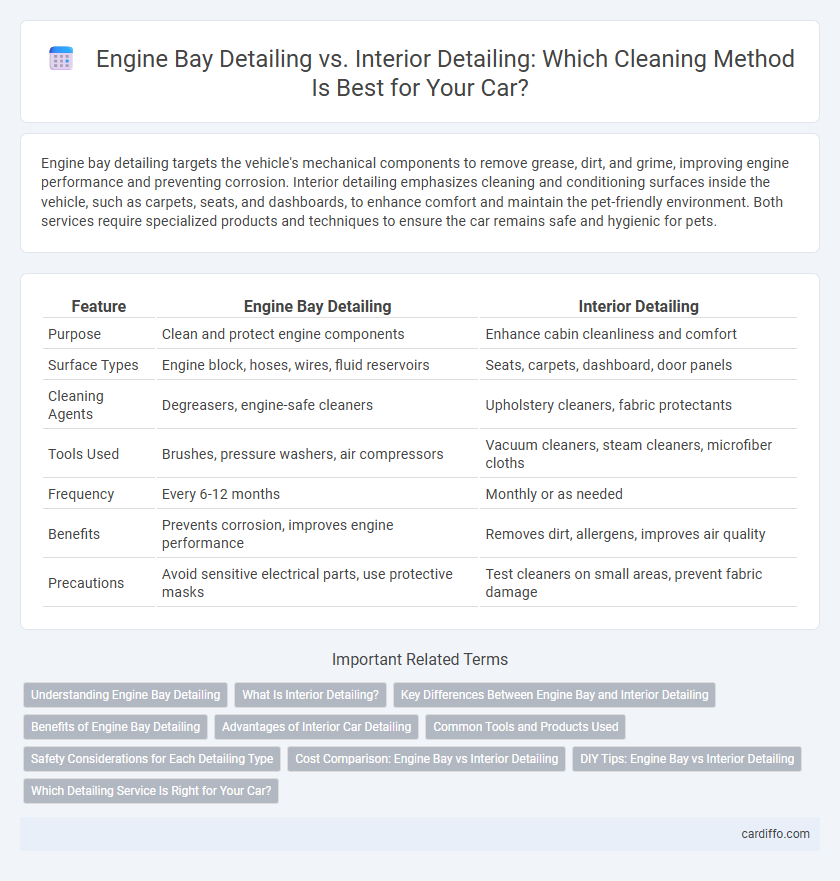Engine bay detailing targets the vehicle's mechanical components to remove grease, dirt, and grime, improving engine performance and preventing corrosion. Interior detailing emphasizes cleaning and conditioning surfaces inside the vehicle, such as carpets, seats, and dashboards, to enhance comfort and maintain the pet-friendly environment. Both services require specialized products and techniques to ensure the car remains safe and hygienic for pets.
Table of Comparison
| Feature | Engine Bay Detailing | Interior Detailing |
|---|---|---|
| Purpose | Clean and protect engine components | Enhance cabin cleanliness and comfort |
| Surface Types | Engine block, hoses, wires, fluid reservoirs | Seats, carpets, dashboard, door panels |
| Cleaning Agents | Degreasers, engine-safe cleaners | Upholstery cleaners, fabric protectants |
| Tools Used | Brushes, pressure washers, air compressors | Vacuum cleaners, steam cleaners, microfiber cloths |
| Frequency | Every 6-12 months | Monthly or as needed |
| Benefits | Prevents corrosion, improves engine performance | Removes dirt, allergens, improves air quality |
| Precautions | Avoid sensitive electrical parts, use protective masks | Test cleaners on small areas, prevent fabric damage |
Understanding Engine Bay Detailing
Engine bay detailing involves thoroughly cleaning and restoring the engine compartment to remove dirt, grease, and grime while protecting sensitive components with specialized degreasers and brushes. This process enhances engine performance by preventing corrosion and overheating risks associated with accumulated debris. Unlike interior detailing, which focuses on cabin surfaces, engine bay detailing requires careful attention to electrical parts and fluid reservoirs to ensure optimal engine health and longevity.
What Is Interior Detailing?
Interior detailing involves a thorough cleaning and restoration of a vehicle's cabin, including seats, carpets, dashboard, and door panels to eliminate dirt, stains, and odors. It uses specialized tools and cleaning agents to deep clean upholstery, remove allergens, and protect surfaces from wear and UV damage. This process enhances the overall hygiene, comfort, and appearance of the vehicle's interior environment.
Key Differences Between Engine Bay and Interior Detailing
Engine bay detailing involves deep cleaning and degreasing of the vehicle's engine compartment to remove dirt, oil, and grime buildup, protecting mechanical components and improving engine performance. Interior detailing focuses on cleaning and conditioning surfaces inside the cabin, such as seats, carpets, dashboard, and upholstery, enhancing comfort and appearance while eliminating odors and allergens. Key differences include the use of specialized degreasers and water-resistant techniques for the engine bay versus gentle cleaners and protectants for delicate interior materials.
Benefits of Engine Bay Detailing
Engine bay detailing removes grease, dirt, and grime from critical engine components, improving heat dissipation and preventing corrosion that can lead to costly repairs. It enhances the overall vehicle hygiene, reducing the risk of contaminants affecting engine performance and longevity. Regular engine bay cleaning also aids in identifying leaks or damages early, contributing to better maintenance and safety.
Advantages of Interior Car Detailing
Interior car detailing enhances cabin air quality by removing dust, allergens, and contaminants from upholstery and vents, promoting healthier driving conditions. It preserves the vehicle's resale value through meticulous cleaning and conditioning of leather, fabric, and dashboard components, preventing premature aging and wear. Deep cleaning of carpets and seats eliminates stubborn stains and odors, ensuring a fresher, more comfortable environment inside the vehicle.
Common Tools and Products Used
Engine bay detailing commonly requires degreasers, engine-safe brushes, and plastic protectants to remove oil and grime while protecting sensitive components. Interior detailing typically uses vacuum cleaners, microfiber cloths, upholstery cleaners, and dashboard protectants to clean and condition carpets, seats, and surfaces. Both processes may utilize detailing sprays, but products are specifically formulated to suit the unique materials and environmental conditions of each area.
Safety Considerations for Each Detailing Type
Engine bay detailing requires careful attention to avoid water or cleaning chemicals damaging sensitive electrical components and connectors, emphasizing the use of protective covers and low-pressure sprays. Interior detailing demands thorough cleaning of air vents, upholstery, and dashboard surfaces while ensuring non-toxic, hypoallergenic cleaning agents to maintain air quality and prevent respiratory irritation. Both detailing types prioritize safety by selecting appropriate tools and products to prevent physical injury and preserve the vehicle's functional integrity.
Cost Comparison: Engine Bay vs Interior Detailing
Engine bay detailing typically costs between $50 and $150, reflecting the specialized cleaning products and time required to remove grease and grime from engine components. Interior detailing ranges from $100 to $250, driven by comprehensive cleaning of carpets, upholstery, and electronics using various tools and conditioners. The price difference arises as interior detailing demands more labor-intensive processes and diverse materials compared to the focused engine bay cleaning.
DIY Tips: Engine Bay vs Interior Detailing
Engine bay detailing requires careful inspection to avoid damaging electrical components, using a plastic-safe degreaser and soft brushes to remove grime without soaking. Interior detailing focuses on vacuuming seats and carpets, wiping down surfaces with a fabric-safe cleaner, and conditioning leather to maintain cleanliness and prevent wear. For DIY enthusiasts, always disconnect the battery before engine cleaning and use microfibre cloths for interior detailing to ensure thorough, scratch-free results.
Which Detailing Service Is Right for Your Car?
Engine bay detailing targets the vehicle's mechanical components, enhancing performance visibility and preventing corrosion, while interior detailing focuses on upholstery, dashboard, and carpets to improve comfort and aesthetics. Choosing the right service depends on your car's current condition and your maintenance priorities--opt for engine bay detailing for mechanical longevity and interior detailing for passenger environment freshness. Regularly scheduled services combine both for maximum vehicle care and value retention.
Engine Bay Detailing vs Interior Detailing Infographic

 cardiffo.com
cardiffo.com